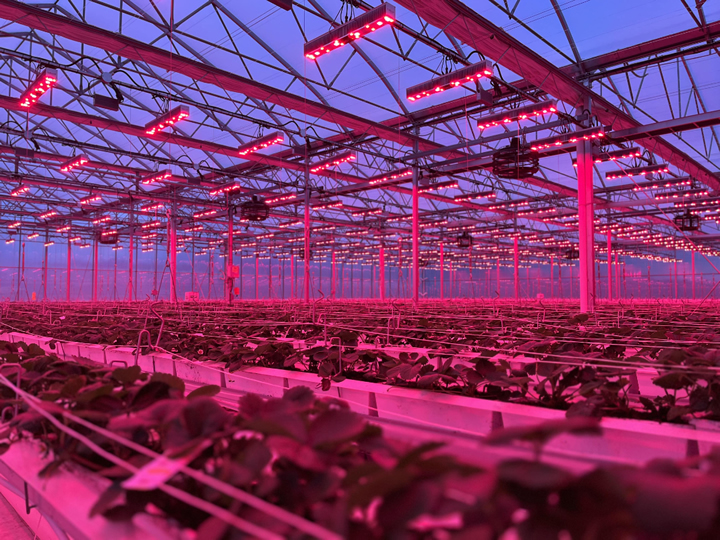Given the numerous unknowns in strawberry lighting and the continuous development of new varieties, many growers have turned to dynamic LED lighting to have the most adaptable lighting for today and the future, with Sollum Technologies leading the way as the top provider.
 Strawberry production seeing strong improvements under dynamic LED lighting
Strawberry production seeing strong improvements under dynamic LED lighting

Case Study from | Sollum Technologies
Given the numerous unknowns in strawberry lighting and the continuous development of new varieties, many growers have turned to dynamic LED lighting to have the most adaptable lighting for today and the future, with Sollum Technologies leading the way as the top provider.
But in what ways is dynamic LED lighting changing the game in greenhouse strawberry production?
Yield improvements season over season
Strawberry growers using Sollum’s dynamic LED lighting solution have seen significant improvements year over year as they learn how to tailor their lighting strategy to the crop’s status and take advantage of more and more features in dynamic lighting. Most growers start using the basic features by creating 2-3 zones and applying rectification for real-time dimming. With time, growers have begun to create more lighting zones, change the light spectrum throughout the season and even apply light treatments.
For two growers in their second year of production, the strawberry yield has increased by 43-60% compared to their first season as they began experimenting with zoning, far-red light treatments and climate adjustments.
Furthermore, five growers have already surpassed their cumulative yield from last season, with three months left of harvesting in the 2023-2024 season. This rapid growth is largely due to adjustments in the lighting strategy with respect to light intensity (PPFD), increased output of red light and a dynamic use of far-red light.

Optimization per variety through zoning and spectral tuning
While the greenhouse strawberry market in North America is dominated by the variety Albion, growers are generally unsatisfied with the variety and are trialing multiple cultivars. With dynamic LED lighting, growers have been able to recreate their lighting zones to map their variety map in the greenhouse. This is essential as plants’ response to light is highly cultivar specific.
For example, one greenhouse using Sollum LED fixtures created zones over each variety and zeroed in on the best far-red strategy per zone and variety.
After applying the same far-red strategy over the whole greenhouse and noticing that the canopy of each variety was different under the same lighting, the grower readjusted the zones to apply either no additional far-red light, 4 hours of far-red light and 2 hours of far-red light at the end of the day. This strategy produced the ideal canopy for all varieties (despite the lighting being completely different) and an average weekly yield of 0.72 kg/m2 in January and February (maximum of 1.20 kg/m2/week), while also optimizing energy consumption.

Improved cultivation compared to HPS
As some growers are retrofitting their greenhouses to produce strawberries, some find themselves with HPS lighting over their strawberry crop. While vine crops can handle the heat produced by HPS lights, the same is not true for strawberries as growers need to apply lower light intensities with HPS fixtures to not overheat the temperature-sensitive strawberry crop.
When using LED lighting, strawberry growers can apply a much higher light intensity, which enhances photosynthesis and improves crop productivity. Strawberry growers can also use LED lighting during the shoulder months (autumn and spring) without worrying about excess heat, allowing them to maintain high flower numbers and fruit set despite highly variable natural light conditions.
After two seasons of comparing strawberry production under dynamic LED and HPS lighting, growers have seen a 27-30% increase in yield under dynamic LED lighting.
With another three months of harvesting ahead for greenhouse strawberry growers in North America, Sollum Technologies is working closely with its strawberry growers to maintain this high productivity into the summer months when supplemental lighting is no longer needed, and to use these learnings to develop dynamic LED lighting strategies for the next strawberry crop, coming in September 2024.
The content & opinions in this article are the author’s and do not necessarily represent the views of AgriTechTomorrow

Sollum Technologies
Sollum Technologies offers a 100% dynamic LED lighting solution that modulates the full spectrum of the Sun's natural light. With our cloud-based platform SUN as a Service® and our smart fixtures, enjoy the flexibility of unlimited light recipes & multi-zone light management, and automatic dimming that provides the right amount of light in real time at any given time to save energy.
Other Articles
Harnessing the Power of Light Intensity and Spectrum for Propagation and Cut Flower Production
More about Sollum Technologies
Comments (0)
This post does not have any comments. Be the first to leave a comment below.
Featured Product

